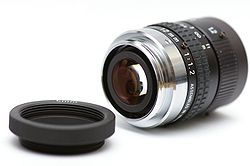
C mount
Encyclopedia

16 mm film
16 mm film refers to a popular, economical gauge of film used for motion pictures and non-theatrical film making. 16 mm refers to the width of the film...
movie camera
Movie camera
The movie camera is a type of photographic camera which takes a rapid sequence of photographs on strips of film which was very popular for private use in the last century until its successor, the video camera, replaced it...
s, closed-circuit television
Closed-circuit television
Closed-circuit television is the use of video cameras to transmit a signal to a specific place, on a limited set of monitors....
cameras, and trinocular microscope
Microscope
A microscope is an instrument used to see objects that are too small for the naked eye. The science of investigating small objects using such an instrument is called microscopy...
phototubes.
C-mount lenses provide a male thread which mates with a female thread on the camera. The thread is nominally 1 inches (25.4 mm) in diameter, with 32 threads per inch, designated as "1-32 UN 2A" in the ANSI
Ansi
Ansi is a village in Kaarma Parish, Saare County, on the island of Saaremaa, Estonia....
B1.1 standard for unified screw threads. The flange focal distance
Flange focal distance
For an interchangeable lens camera, the flange focal distance of a lens mount system is the distance from the mounting flange to the...
is 17.526 millimetre (0.69 in) for a C mount.
Merely to say that a lens is "C-mount" says very little about the lens' intended use. Unlike all other lens mounts, each of which is used for only a single format, C-mount lenses have been made for many different formats, the largest being 4 times as large as the smallest. The vast majority of C-mount lenses are built for the 8-mm and 16-mm film formats and the 1/3-, 1/2-, 2/3-, and 1-inch video formats, which corresponds to a range of image circles from 5 to 17 mm diameter, approximately. Some manufacturers have recently introduced lenses for the 4/3 inch / 1.3 inch format but these remain very expensive.
This is no trivial difference. For example, for the 4/3 format, a 12-mm lens is a wide-angle lens and will have a retrofocus design. For the 2/3 inch format, a 12mm lens is "normal" and can have a simple and fast double Gauss layout. For the 1/3 inch format, a 12-mm lens is long and can have a telephoto design.
Some TV lenses lack provision to focus or set exposure, so may not operate properly with film cameras. Also, some TV lenses may have bits that protrude behind the mount far enough to interfere with the shutter or reflex finder mechanisms of a film camera.
Although C-mount lenses have a back focal distance far too short to be used with 35mm film SLRs or any existing digital SLR, they can be mounted on interchangeable-lens mirrorless digital cameras. One such system is the Micro Four Thirds
Micro Four Thirds system
The Micro Four Thirds system is a standard created by Olympus and Panasonic, and announced on August 5, 2008, for mirrorless interchangeable lens digital cameras and camcorders design and development...
, being used by Olympus and Panasonic. However, the vast majority of C-mount lenses produce an image circle too small to light up the entire (micro-)four-thirds sensor, with its approximately 22-mm diagonal. This produces what is popularly called "vignetting" but is better described as a mismatch between camera format and lens format.
The letter "C" is said to stand for "cine
Çine
Çine is a town and a district of Aydın Province, in the Aegean region of Turkey, from the city of Aydın, on the road to Muğla.- Geography :Formerly known as Kıroba, Çine is an attractive rural district in the southern part of the valley of the Büyük Menderes River, on the southern flank of Madran...
", the original application being movie camera lenses.
CS mount
CS-mount has a flange focal distanceFlange focal distance
For an interchangeable lens camera, the flange focal distance of a lens mount system is the distance from the mounting flange to the...
of 12.5 millimetre (0.492125984251969 in), but is otherwise the same as C-mount, including the fact that lenses for many different formats are made for it. CS-mount lenses are built for the smaller formats, 1/2 inch and down.
| Camera body |
extension tube adapter |
Lens | Net Effect |
Focus | View angle |
Zoom | Exposure |
|---|---|---|---|---|---|---|---|
| C | C | Normal | Normal | Normal | Normal | ||
| C | CS | +5mm | Near-sighted | Narrower | Larger | Darker | |
| C | 5 millimetre (0.196850393700787 in) | C | +5mm | Near-sighted | Narrower | Larger | Darker |
| C | 5 millimetre (0.196850393700787 in) | CS | +10mm | Most Near-sighted | Narrowest | Largest | Darkest |
| CS | C | -5mm | Far-sighted | Wider | Smaller | Brighter | |
| CS | CS | Normal | Normal | Normal | Normal | ||
| CS | 5 millimetre (0.196850393700787 in) | C | Normal | Normal | Normal | Normal | |
| CS | 5 millimetre (0.196850393700787 in) | CS | +5mm | Near-sighted | Narrower | Larger | Darker |
External links
- Making Digital Camera Microscope Adapters. The section "Understanding C-Mount and CS-Mount Standard Mechanics, Optics, and Cameras" discusses the standards and custom machining of C-mount apparatus.
- List of some C-mount lenses. Collection of cine optics and photos of them.

